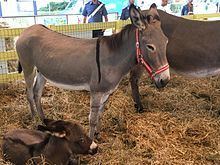Conservation status FAO: endangered Country of origin Italy Scientific name Equus africanus asinus Rank Breed | Other names Asino dell'Amiata | |
 | ||
Use transportburdenlight draughtmeathippotherapy Weight Male: 200 kgFemale: 150 kg Similar Bardigiano, Zamorano‑Leonés, Sardinian Anglo‑Arab, Massese sheep, Esperia Pony | ||
The Amiatina or Italian: Asino dell'Amiata is a breed of donkey from Tuscany in central Italy. It is particularly associated with Monte Amiata in the provinces of Siena and Grosseto, but is distributed throughout Tuscany. There are also populations in Liguria and in Campania.:156 It is one of the eight autochthonous donkey breeds of limited distribution recognised by the Ministero delle Politiche Agricole Alimentari e Forestali, the Italian ministry of agriculture and forestry.:18
Contents
History
The Amiatina was numerous in the early part of the twentieth century; before the Second World War the population in the provinces of Grosseto and Perugia alone was over 8000. In the years following the War it came close to extinction. From 1956 the Deposito Stalloni (later the Istituto di Incremento Ippico) of Pisa selectively bred it in the province of Grosseto. A breeders' association was founded in 1993. In 1995 the registered population was 89. In 2006 the total number registered was 1082, of which about 60% were in Tuscany.:156 The Amiatina was listed as "endangered" by the FAO in 2007.:70
Characteristics
The Amiatina is intermediate in size between large breeds such as the Martina Franca and the Ragusano and small ones such as the Sarda. It rarely exceeds 140 cm at the withers. The coat is mouse-grey, with well-defined primitive markings – dorsal and shoulder stripes forming a cross, and zebra stripes on the legs. It is a strong and rustic breed, capable of foraging on harsh marginal terrain. Management is almost always free range.:157
